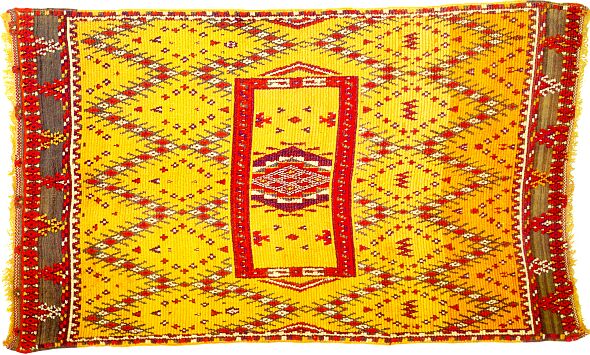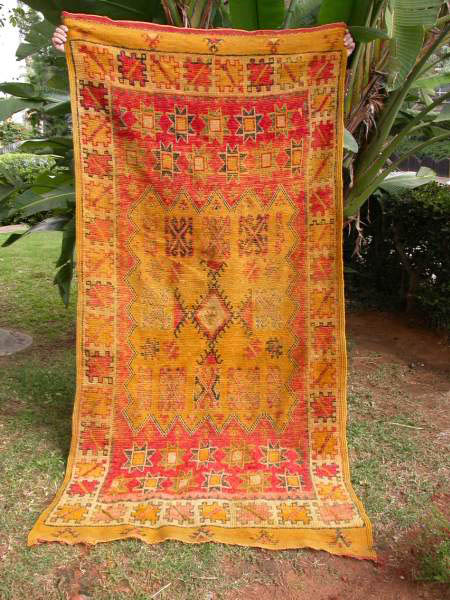
Carpets. Moroccan carpets and textiles come in a wide variety of sizes, colors, designs, and materials. Some are still hand-knotted and dyed with natural vegetable pigments. Berber (or rural) carpets are often thick and woolen and their colors—beige, brown, and tan—reflect the mountainous landscape where the Berbers live. Urban carpets, introduced to Morocco from the east in the 18th century, often feature a multitude of designs in bands of unequal width within a rectangular frame. Top quality can cost thousands of dirhams. Fez has been the country's principal center of weaving since the 16th century while small country souks (markets) outside of Marrakech are good spots to find something special. Meknes and Rabat are known for their embroidered carpets.
 Leather goods. Moroccan artisans produce a wide variety of leather goods, from unpolished bags and satchels to Koran covers and babouches, the quintessential Moroccan slipper, flat-soled and heel-less, most often white, beige, yellow, or red in color. As with Moroccan carpets, quality and price often go hand in hand when purchasing the leather goods found in most cities' souks. In Fez, as in other cities, you can even see the elaborate process of preparing the animal skins and dyeing the leather in vats of salts, oils, and dyes.
Leather goods. Moroccan artisans produce a wide variety of leather goods, from unpolished bags and satchels to Koran covers and babouches, the quintessential Moroccan slipper, flat-soled and heel-less, most often white, beige, yellow, or red in color. As with Moroccan carpets, quality and price often go hand in hand when purchasing the leather goods found in most cities' souks. In Fez, as in other cities, you can even see the elaborate process of preparing the animal skins and dyeing the leather in vats of salts, oils, and dyes.Jewelry. Mostly silver, Moroccan jewelry can be chunky and heavy, often bearing deeply etched designs. Production techniques include casting, enameling, filigree, and engraving. Andalusian and Jewish immigrants have influenced many of these techniques. Products include bracelets, rings, necklaces, earrings, and even decorated daggers. Beware of silver-plating. As with all Moroccan handicrafts, the souks, often within every major city's medina, will feature a wide range of jewelry in terms of type, quality, and price.

Marquetry. An intricate art form, marquetry is a decorative process in which wooden goods are inlaid with veneers, copper and silver wire, ebony, and mother of pearl in floral or geometric patterns. Moroccan artisans inlay a variety of products including furniture, picture frames, ornaments, chess sets, and trinket boxes. While an item's quality of finish may be less than ideal, best check the item's hinges and joints to be sure you're getting a good product (and deal). The woodworkers' atelier in Essaouira is the best place to buy marquetry products and to watch them be painstakingly created. The woodworkers in Marrakech and Azrou use local cedar and olive tree wood. In Fez, the products are typically brightly painted chests and baby cribs.

Ceramics. From rough-hewn, utilitarian glazed red and brown earthenware to enameled decorative pieces, Moroccan artisans create a wide variety of ceramics: jugs, vases, and tableware (cups, saucers, and cooking pots to make tagines). Some are glazed, others bedecked with gilt motifs; intricate, geometric, curved, or cross-stitched designs; and a variety of glazed or metallic finishes. Beware of the gaudy products peddled in touristed towns. Safi, the country's main ceramics center, is known for its darker-colored ceramics while Fez's artisans produce attractive cobalt blue pieces and Meknes is known for its well-finished Damascene ware.
Clothing. The djellabah, an ankle-length, loose-fitting robe with a pointed hood is Moroccans' traditional dress. Some are made of fine wool while others are composed of homespun yarn. Women's djellabahs are often made with a greater range of fabric types, tend to be tighter fitting, and often bear decorative stitching while men's are baggier, plainer, and generally lighter in color.
Brass and copperware. Fez and Marrakech are best known for their brass and copperware; trays, braziers, door knockers, teapots, incense burners, candelabras, and lanterns. Many bear Arabesque or floral motifs. Wrought-iron legs can be added to the largest trays to make a unique table for entertaining. Sapphire, ruby, emerald, and topaz-colored sheets of glass are added to the lanterns to project a brooding, mysterious aura when lit.
